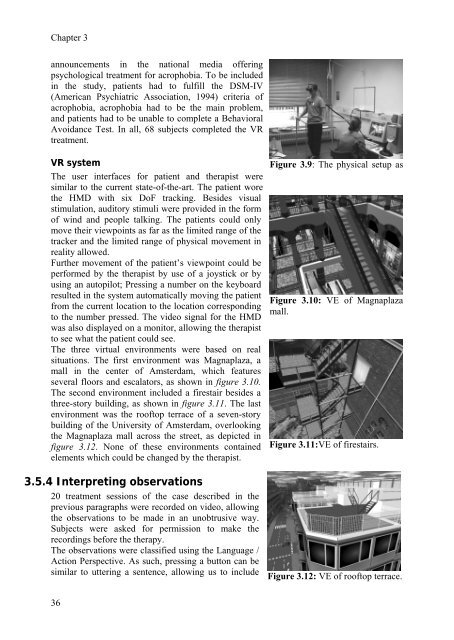Human-Computer Interaction and Presence in Virtual Reality
Human-Computer Interaction and Presence in Virtual Reality
Human-Computer Interaction and Presence in Virtual Reality
Create successful ePaper yourself
Turn your PDF publications into a flip-book with our unique Google optimized e-Paper software.
Chapter 3<br />
announcements <strong>in</strong> the national media offer<strong>in</strong>g<br />
psychological treatment for acrophobia. To be <strong>in</strong>cluded<br />
<strong>in</strong> the study, patients had to fulfill the DSM-IV<br />
(American Psychiatric Association, 1994) criteria of<br />
acrophobia, acrophobia had to be the ma<strong>in</strong> problem,<br />
<strong>and</strong> patients had to be unable to complete a Behavioral<br />
Avoidance Test. In all, 68 subjects completed the VR<br />
treatment.<br />
VR system<br />
The user <strong>in</strong>terfaces for patient <strong>and</strong> therapist were<br />
similar to the current state-of-the-art. The patient wore<br />
the HMD with six DoF track<strong>in</strong>g. Besides visual<br />
stimulation, auditory stimuli were provided <strong>in</strong> the form<br />
of w<strong>in</strong>d <strong>and</strong> people talk<strong>in</strong>g. The patients could only<br />
move their viewpo<strong>in</strong>ts as far as the limited range of the<br />
tracker <strong>and</strong> the limited range of physical movement <strong>in</strong><br />
reality allowed.<br />
Further movement of the patient’s viewpo<strong>in</strong>t could be<br />
performed by the therapist by use of a joystick or by<br />
us<strong>in</strong>g an autopilot; Press<strong>in</strong>g a number on the keyboard<br />
resulted <strong>in</strong> the system automatically mov<strong>in</strong>g the patient<br />
from the current location to the location correspond<strong>in</strong>g<br />
to the number pressed. The video signal for the HMD<br />
was also displayed on a monitor, allow<strong>in</strong>g the therapist<br />
to see what the patient could see.<br />
The three virtual environments were based on real<br />
situations. The first environment was Magnaplaza, a<br />
mall <strong>in</strong> the center of Amsterdam, which features<br />
several floors <strong>and</strong> escalators, as shown <strong>in</strong> figure 3.10.<br />
The second environment <strong>in</strong>cluded a firestair besides a<br />
three-story build<strong>in</strong>g, as shown <strong>in</strong> figure 3.11. The last<br />
environment was the rooftop terrace of a seven-story<br />
build<strong>in</strong>g of the University of Amsterdam, overlook<strong>in</strong>g<br />
the Magnaplaza mall across the street, as depicted <strong>in</strong><br />
figure 3.12. None of these environments conta<strong>in</strong>ed<br />
elements which could be changed by the therapist.<br />
3.5.4 Interpret<strong>in</strong>g observations<br />
20 treatment sessions of the case described <strong>in</strong> the<br />
previous paragraphs were recorded on video, allow<strong>in</strong>g<br />
the observations to be made <strong>in</strong> an unobtrusive way.<br />
Subjects were asked for permission to make the<br />
record<strong>in</strong>gs before the therapy.<br />
The observations were classified us<strong>in</strong>g the Language /<br />
Action Perspective. As such, press<strong>in</strong>g a button can be<br />
similar to utter<strong>in</strong>g a sentence, allow<strong>in</strong>g us to <strong>in</strong>clude<br />
36<br />
Figure 3.9: The physical setup as<br />
used for the therapy.<br />
Figure 3.10: VE of Magnaplaza<br />
mall.<br />
Figure 3.11:VE of firestairs.<br />
Figure 3.12: VE of rooftop terrace.
















